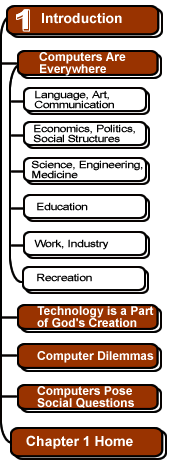

Computers in Work, Industry
| Information technologies contributed more than a third of real U.S. economic growth between 1995 and 1997. Carol
Ann Meares and John F. Sargent, Jr., THE
DIGITAL WORK FORCE: Building Infotech Skills at the Speed of
Innovation, U.S. Department of Commerce Technology Administration
Office of Technology Policy (June 1999), 5. |
Information technology can be found on the factory floor, in the corporate office, in the field, and at the CEO's desk.
Robotics are commonplace on the assembly line today, where human workers were formerly necessary.
Computers are being used not only to track accounting information but also to archive and share corporate data, provide precise manufacturing process control, and simulate anticipated consumer response to new products.
Telecommuting (working from home by using a computer to connect to the corporate network) has become commonplace, providing employees with new flexibility in their work hours. Computers have changed entire industries.
Consider, for example, how computers changed the cost structures in 1997 for transaction servicing by financial institutions:
| A bank's cost to process a simple transaction like a withdrawal or a check the old way from teller to back office is $1.40; for an ATM transaction it is $0.45, and for an electronic bank-to-bank exchange, $0.08. Michael L. Dertouzos, What Will Be (San Francisco: HarperEdge, 1997), 106. |
These pages were written by Jeffrey L. Nyhoff and Steven H. VanderLeest
and edited by Nancy Zylstra
© 2005 Calvin University (formerly Calvin College), All Rights Reserved.
If you encounter technical errors, contact computing@calvin.edu.